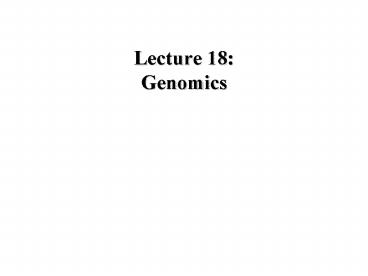Lecture 18: Genomics - PowerPoint PPT Presentation
1 / 15
Title:
Lecture 18: Genomics
Description:
large-scale' and high-throughput' study on genes or. genomes using molecular biology ... prepare a a large number. of clones wth different inserted DNA. up to ... – PowerPoint PPT presentation
Number of Views:98
Avg rating:3.0/5.0
Title: Lecture 18: Genomics
1
Lecture 18Genomics
2
Outline
- Genomics in general
- DNA sequencing method
- Human Genome Project
- What to learn from HGP
- Bioinformatics
- predicting Open Reading Frame
- comparing two sequences ---gt information
3
Genomics in general
- originated from the journal name mid 1980s
- gene mapping, molecular cloning, large-scale DNA
sequencing and - computational analysis
- large-scale and high-throughput study on
genes or - genomes using molecular biology
- ------gt system biology (more advanced form of
genomics) - structural versus functional genomics
- organization and evolution of genomics
(Comparative genomics)
4
What to learn from Genomics
- Analyzing organisms using genome sequences
- Genomics can provide many unknown functional
aspects of any given gene - for example, gene locations and surrounding
genes ----gt - affect function of another gene
- Comparing genome sequence derived from different
species - similarities and differences at DNA sequence
levels between species - evolution patterns of individual genes can
provide insightful hints regarding genes - functions
- genes that are involved in fundamental functions
of organisms - (YY1)
- versus
- genes that are involved in species-specific
functions - (olfactory receptor genes and vomeronasal organ
receptor genes)
5
DNA sequencing methods
- Chain termination method (Sanger et al., 1977)
- enzymatic method with polymerase substrate
inhibitors - dideoxynucleotides (ddA, ddG, ddC, ddT)
- - requires primer and single-stranded template
DNAs - Chemical degradation Method (Maxam and Gilbert,
1977) - chemical degradation method
- sequence-specific cutting with chemicals
- require double-stranded DNAs
- The Sanger method is widely used now mainly due
to the easiness, - automation capability and non-toxicity.
6
The chain termination method
- require polymerase (T4)
- dNTPs with ddNTPs (101 ratio)
- template DNAs
- primers
- each DNA sample requires
- 4 different chain terminaton rxns
- (ddA, ddG, ddC, ddT)
7
The chain termination method
8
The chain termination method
- four different rxn mixtures are separated
- in different lanes of sequencing gels
- detection by autoradiogram
- the primer is labeled with isotopes
9
The chain termination method
- New method for detecting
- automated sequencing
- with fluroscence-labled ddNTP
10
Sequencing of long DNAs
- the current sequencing method
- can sequence up to 500 bp in length
- to sequence one large DNA
- chromosomes (1x108 bp in length),
- you need to prepare a a large number
- of clones wth different inserted DNA
- up to million clones
- a huge effort for sequencing human
- genome ------gt Human Genome Project!
11
Human Genome Project
- sequencing the entire human genome (3x109 base
pair long) - started mid 1980s by a group of scientist
- the working draft-stage human genome
- sequence was published 2000
- spent about 3 billions dollars (?)
- the original sequencing strategy
- was top-to-bottom approach
12
Human Genome Project
URL---gt file//localhost/Volumes/digital_content_m
anager/digital_content/animations_library/genome.h
tm
13
Trivia question 1 for HGP How much of human
body is DNA?
- Molecular weight (M.W.) of Human Genome
- 660 grams per base x 3x109 bases 2.0 x 1012
grams - 1 avogadros number 6 x 1023
- 2.0 x 1012 / 6 x 1023 3.3 x 10-12 grams 3.3
picograms - Human body 1013 cells
- 3.3 x 10-12 x 1013 x 2 66 grams
- 66 grams / 66 kilograms 0.1
- 0.1 of our body is DNA
14
Trivia question 2 for HGP How long is human
genomic DNA?
- As a string of DNA
- 0.34 nm per base 3.4 x 10-10 meters
- 3.4 x 10-10 x 3 x 109 1.02 meters
- As a written sequence book
- one page of books 3000 letters
- one book 1000 pages 3,000,000 letters 3 x
106 letters - 3 x109 bases (letters) / 3 x 106 letters 1000
books - Human genome is equivalent to 1,000 books
- Can we read through and analyze these important
books with our naked eyes? - computer help --------gt bioinformatics!
15
Notes for the final exam and others
The homework for this week ------gt Chapter 9
2, 11, 12, 13, 14, 15 Final grades 3 sets of
exams Review session for the final exam ----gt
discussion session in the next week No homework
for the next week































